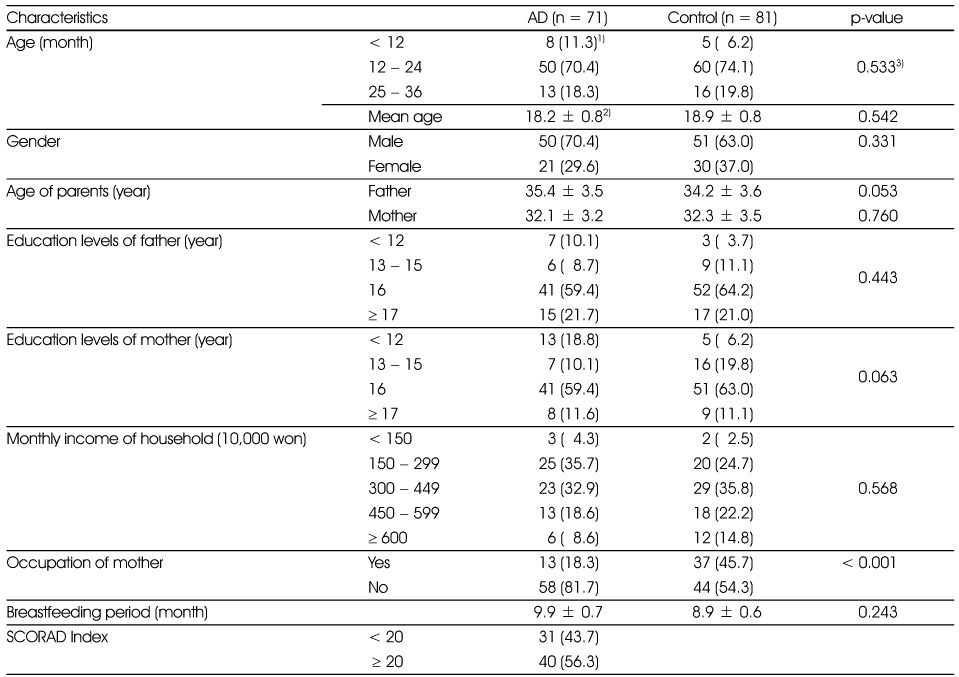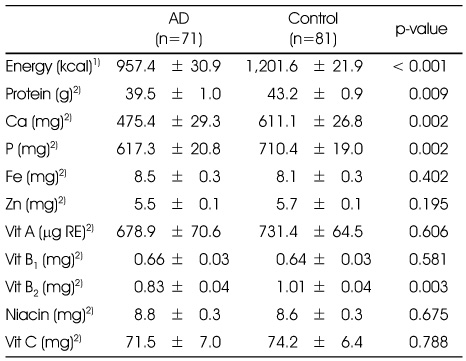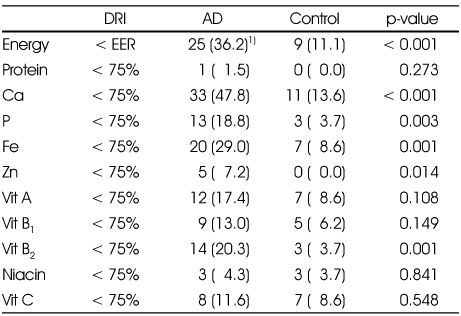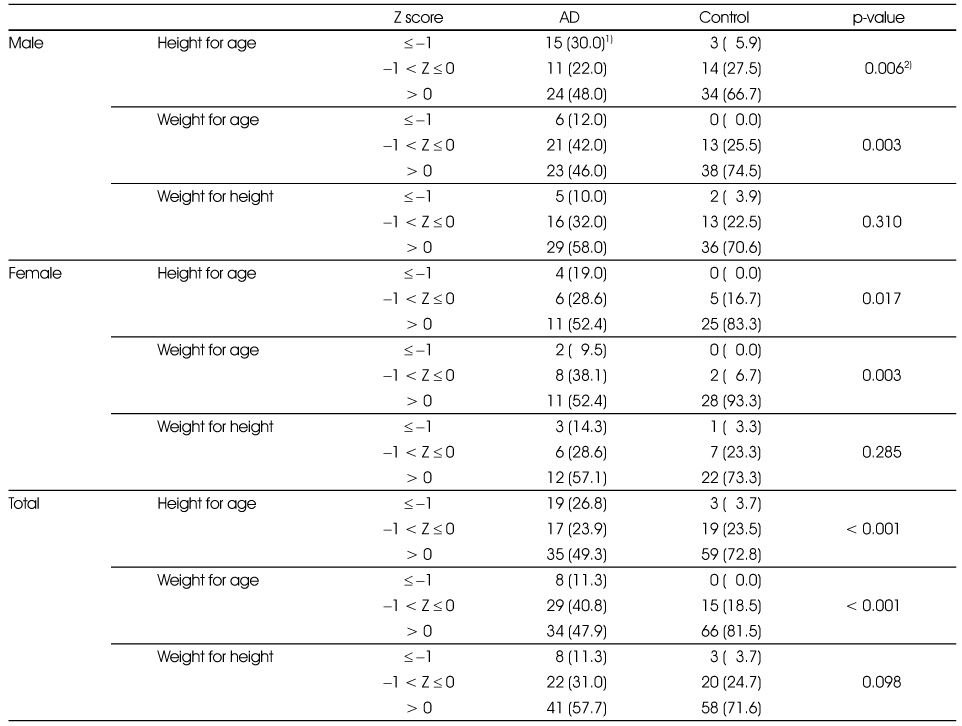Articles
- Page Path
- HOME > Korean J Community Nutr > Volume 17(3); 2012 > Article
-
Original Article
- The Comparison of Growth and Nutrient Intakes in Children with and without Atopic Dermatitis
- Seung-joo Park, Jae Sun Lee, Kangmo Ahn, Sang-Jin Chung
-
Korean Journal of Community Nutrition 2012;17(3):271-279.
DOI: https://doi.org/10.5720/kjcn.2012.17.3.271
Published online: June 30, 2012
Department of Foods and Nutrition, Kookmin University, Seoul, Korea.
1Center for Health Promotion, Healthcare Center, Samsung Medical Center, Seoul, Korea.
2Department of Pediatrics, Samsung Medical Center, Sungkyunkwan University School of Medicine, Seoul, Korea.
- Corresponding author: Sang-Jin Chung, Department of Foods and Nutrition, Kookmin University, 861-1 Jeongneungdong, Seongbukgu, Seoul 136-702, Korea. Tel: (02) 910-4777, Fax: (02) 910-5249, schung@kookmin.ac.kr
Copyright © 2012 The Korean Society of Community Nutrition
- 1,015 Views
- 4 Download
- 11 Crossref
Abstract
- The prevalence of atopic dermatitis (AD) has increased recently all over the world. Several studies worldwide reported growth retardation associated with AD, but few studies were reported in Korea. Therefore, the objective of this study was to identity the differences in growth and nutrient intakes between Korean children with and without AD. The participants were 71 AD children and age, gender-matched 81 control children aged 10 to 36 months. Demographic information was gathered by questionnaires. Height and weight were measured at clinic and health centers. Height and weight for age, and weight for height were converted as deviation in Z scores using World Health Organization Standard. A 24 hour dietary recall method was performed to estimate nutrient intakes. A higher percentage of AD children had insufficient energy and intakes of calcium, phosphorus, iron, zinc and vitamin B2 , defined as intakes lower than 75% of the Dietary Reference Intakes for Korean, compared to the control group (P < 0.001, P < 0.001 0.001, P = 0.003, P = 0.001, P = 0.014, P = 0.001, respectively). The percentages of children with height and weight for age Z score below than-1 (stunted) were significantly higher in the AD group (P < 0.001 0.001 and P < 0.001 0.001, respectively). Multiple food restriction, defined as ≥ 3 food elimination, was associated with insufficient energy and intakes of calcium, phosphorus, iron, zinc, vitamins A and B2 . In conclusion, children with AD need regular nutrient assessment and education about alternative food choices to avoid r food elimination in order to prevent growth retardation or inadequate nutrient intakes. Further longitudinal studies for growth and nutrient intakes should be performed to understand the patterns of growth in children with AD.
-
This work was supported by the Korea Research Foundation Grant funded by the Korean Government (MOEHRD) (KRF-2007-331-C00281).
NOTES
- 1. Agostoni C, Grandi F, Scaglioni S, Gianni ML. Growth pattern of breastfed and nonbreastfed infants with atopic dermatitis in the first year of life. Pediatrics. 2000; 106: E73.ArticlePubMedPDF
- 2. Ahn HS. Growth and development. Textbook of pediatrics. 2007; 9th ed. Seoul: Daehan; 13-36.
- 3. Barth GA, Weigl L, Boeing H, Disch R, Borelli S. Food intake of patients with atopic dermatitis. Eur J Dermatol. 2001; 11(3): 199-202.PubMed
- 4. Baum WF, Schneyer U, Lantzsch AM, Klöditz E. Delay of growth and development in children with bronchial asthma, atopic dermatitis and allergic rhinitis. Exp Clin Endocrinol Diabetes. 2002; 110: 53-59.ArticlePubMed
- 5. Burks AW, Mallory SB, Williams LW, Shirrell MA. Atopic dermatitis: clinical relevance of food hypersensitivity reactions. J Pediatr. 1988; 113(3): 447-451.ArticlePubMed
- 6. Chang EY, Chung SW, Lee JH. Mother's experience of caring child with a severe atopic dermatitis. Korean Parent Child Health J. 2006; 9(1): 17-32.
- 7. Chung SJ, Han YS, Chung SW, Ahn GM, Park HY, Lee SY, Cho YY, Choi HM. Marasmus and Kwashiorkor by nutritional ignorance related to vegetarian diet and infants with atopic dermatitis in South Korea. Korean J Nutr. 2004; 37: 540-549.
- 8. Christie L, Hine RJ, Parker JG, Burks W. Food allergies in children affect nutrient intake and growth. J Am Diet Assoc. 2002; 102(11): 1648-1651.ArticlePubMed
- 9. Durmus B, van Rossem L, Duijts L, Arends LR, Raat H, Moll HA, Hofman A, Steegers EA, Jaddoe VW. Breast-feeding and growth in children until the age of 3 years: the generation r study. Br J Nutr. 2011; 105(11): 1704-1711.ArticlePubMed
- 10. Eigenmann PA, Sicherer SH, Borkowski TA, Cohen BA, Sampson HA. Prevalence of IgE-mediated food allergy among children with atopic dermatitis. Pediatrics. 1998; 101(3): E8.ArticlePDF
- 11. Greer FR, Sicherer SH, Burks AW. American Academy of Pediatrics Committee on Nutrition. American Academy of Pediatrics Section on Allergy and Immunology. Effects of early nutritional interventions on the development of atopic disease in infants and children: the role of maternal dietary restriction, breastfeeding, timing of introduction of complementary foods, and hydrolyzed formulas. Pediatrics. 2008; 121(1): 183-191.ArticlePubMedPDF
- 12. Geneva. Physical status: the use and interpretation of anthropometry. Report of a WHO Expert Committee. World Health Organ Tech Rep Ser. 1995; 854: 1-452.PubMed
- 13. Han YS, Chung SJ, Cho YY, Choi HM, Ahn GM, Lee SY. Analysis the food allergen sensitization in children with atopic dermatitis in Korea. Korean J Community Nutr. 2004; 9(1): 90-97.
- 14. Hanifin J, Rajka G. Diagnostic feature of atopic dermatitis. Acta Derm Venereol. 1980; 92(S): 44-47.
- 15. Isolauri E, Sütas Y, Salo MK, Isosomppi R, Kaila M. Elimination diet in cow's milk allergy: risk for impaired growth in young children. J Pediatr. 1998; 132(6): 1004-1009.ArticlePubMed
- 16. Kim JH, Lee HC, Jang JH, Ahn KM, Han YS, Lee SI. Risk factors influencing growth in children with atopic dermatitis. Pediatr Allergy Respir Dis. 2008; 18(4): 339-348.
- 17. Kristmundsdottir F, David TJ. Growth impairment in children with atopic eczema. J R Soc Med. 1987; 80(1): 9-12.ArticlePDF
- 18. Kunz B. Clinical validation and guidelines for the SCORAD Index: consensus report of the European task force on atopic dermatitis. Dermatology. 1997; 195(1): 10-19.ArticlePDF
- 19. Lee SI. Common allergic diseases in children. J Korean Med Assoc. 2003; 46(3): 231-243.Article
- 20. Lee SH, Lee HJ, Han YS, Ahn KM, Chung SJ. Excessive food restriction in children with atopic dermititis. Korean J Community Nutr. 2011; 16(6): 627-635.Article
- 21. Massarano AA, Hallis S, Devlin J, David TJ. Growth in atopic eczema. Arch Dis Child. 1993; 68(5): 677-679.ArticlePubMedPMC
- 22. Ministry of Health and Welfare & Korea Center for Disease Control and Prevention. Korea National Health and Nutrition Examination Survey (KNHANESIV-3). 2010.
- 23. Niggemann B, Sielaff B, Bayer K, Binder C, Wahn U. Outcome of double-blind, placebo-controlled food challenge tests in 107 children with atopic dermatitis. Clin Exp Allergy. 1999; 29(1): 91-96.ArticlePubMedPDF
- 24. Noimark L, Cox HE. Nutritional problems related to food allergy in childhood. Pediatr Allergy Immunol. 2008; 19(2): 188-195.PubMed
- 25. Oh JW, Kim KE, Pyun BY, Lee HR, Choung JT, Hong SJ. Nationwide study for epidemiological change of atopic dermatitis in school aged children between 1995 and 2000 and kindergarten aged children in 2003 in Korea. Pediatr Allergy Respir Dis. 2003; 13(4): 227-237.
- 26. Oh JW. Food and atopic dermatitis in children. Safe Food. 2006; 1(2): 18-24.
- 27. Palit A, Honda S, Bhalla AK, Kumar B. A mixed longitudinal study of physical growth in children with atopic dermatitis. Indian J Dermatol Venereol Leprol. 2007; 73(3): 171-175.ArticlePubMed
- 28. Sampson HA, McCaskill CC. Food hypersensitivity and atopic dermatitis: evaluation of 113 patients. J Pediatr. 1985; 107(5): 669-675.PubMed
- 29. Skolnick H, Barnes Koerner C, Connover-Walker MK, Sampson HA, Wood RA. The natural history of peanut allergy. J Allergy Clin Immunol. 2001; 107(2): 367-374.ArticlePubMed
- 30. The Korean Dietitian Association. Picture book for estimating food amount by looking. 1999; Seoul.
- 31. The Korean Nutrition Society. Dietary reference intakes for Koreans, first revision. 2010; Seoul: The Korean Nutrition Society.
- 32. Wahlgren CF. Pathophysiology of itching in urticaria and atopic dermatitis. Allergy. 1992; 47(2): 65-75.PubMed
- 33. Willett W. Nutritional epidemiology. 1998; North Carolina: Oxford University Press.
REFERENCES
Figure & Data
REFERENCES
Citations

- Relationship between intake of soft drinks and current prevalence of adult atopic dermatitis: based on the Korea National Health and Nutrition Examination Survey data (2015-2016)
Hye Won Kim, Ji-Myung Kim
Journal of Nutrition and Health.2021; 54(5): 501. CrossRef - The status of food allergy and parental burden of preschoolers in Jeju area
Jeong Eun Oh, Eunyoung Kim, Yunkyoung Lee
Journal of Nutrition and Health.2021; 54(6): 664. CrossRef - Evaluation of nutritional status and adequacy of energy and nutrient intakes among atopic dermatitis children under 12 years of age: based on Korea National Health and Nutrition Examination Survey data (2013–2015)
Hye Won Kim, Ji-Myung Kim
Journal of Nutrition and Health.2020; 53(2): 141. CrossRef - Food Allergy-related Awareness and Performance of Dietitians at Children's Hospitals in Korea: Comparison of Certificate Possession among Clinical Dietitians
Hye-Ran Shin, Sook-Bae Kim
Korean Journal of Community Nutrition.2019; 24(6): 512. CrossRef - Relation of Nutritional Intake and Allergic Rhinitis in Infants: Using the Korea National Health and Nutrition Examination Survey (KNHANES) 2013~2016
Eun-Sil Her, Bo-Young Seo
Korean Journal of Community Nutrition.2019; 24(4): 321. CrossRef - Food allergic reactions in the community: a questionnaire survey of caregivers
An Deok Seo, Jun Yeol Lee, Song I Yang, Hye Ran Lee, So-Yeon Lee
Allergy, Asthma & Respiratory Disease.2017; 5(1): 27. CrossRef - The change in food allergy prevalence of elementary school children in Seoul since the last 20 years and the risk factor analysis
Yeong-Ho Kim, So-Yeon Lee, Eun Lee, Hyun-Ju Cho, Hyo-Bin Kim, Ji-Won Kwon, Song-I Yang, Eun-Jin Kim, Jeom-Kyu Lee, Soo-Jong Hong
Allergy, Asthma & Respiratory Disease.2016; 4(4): 276. CrossRef - Nutrient intakes of infants with atopic dermatitis and relationship with feeding type
Youngshin Han, Youngmi Lee, Haeryun Park, Sunyoung Park, Kyunghee Song
Nutrition Research and Practice.2015; 9(1): 57. CrossRef - Perception on food allergy labelling and management of nutritional education among higher grade elementary school students in Jeju area
Yunkyoung Lee, Hyun-Hee Kim, Yang-Sook Ko
Journal of Nutrition and Health.2015; 48(6): 530. CrossRef - Survey of food allergy in elementary school children in Bucheon-city and relationship between food allergy and other allergic diseases
Jae Young Park, Ga Young Park, Young Shin Han, Mee Yong Shin
Allergy Asthma & Respiratory Disease.2013; 1(3): 266. CrossRef - Nutrient Intake and Food Restriction in Children with Atopic Dermatitis
Hyunjin Lim, Kyunghee Song, Ran Kim, Jiyeon Sim, Eunah Park, Kangmo Ahn, Jihyun Kim, Youngshin Han
Clinical Nutrition Research.2013; 2(1): 52. CrossRef
Children's general characteristics in the study
1) N (%)
2) Mean ± SE, p value by Student t-test
3) p-value by chi-square test among the two groups
AD: Atopic Dermatitis, SCORAD (scoring of atopic dermatitis)
Comparison of children's average nutrients intakes in AD and control
1) Mean ± SE, p value by Student t-test
2) Adjusted Mean ± SE, p-value by ANCOVA(Anaysis of covariance) after adjusting energy intake
AD: Atopic Dermatitis
Percentage of children consuming nutrients less than 75% of DRIs in AD and control
1) N (%)
DRI: Adequate Intake or Recommended Intake
AD: Atopic Dermatitis
Protein: Recommended intake per weight kg
EER: Estimated Energy Requirement
p-value by chi-square test among two groups
The number and food groups eliminated in diet of children with AD
1) N (%)
AD: Atopic Dermatitis
Linear trend of percentage of subjects consuming nutrients less than 75% of DRIs in control and AD groups divided by number of food eliminated (<3 vs ≥3)
1) N (%)
AD: Atopic Dermatitis
DRI: Adequate Intake or Recommended Intake
EER: Estimated Energy Requirement
Protein : Recommended intake per weight kg
p-value by linear trend among three groups
Comparison of growth status by Z score standard between AD and control
1) N (%)
2) p-value by chi-square test among two groups
AD: Atopic Dermatitis
1) N (%) 2) Mean ± SE, p value by Student t-test 3) p-value by chi-square test among the two groups AD: Atopic Dermatitis, SCORAD (scoring of atopic dermatitis)
1) Mean ± SE, p value by Student t-test 2) Adjusted Mean ± SE, p-value by ANCOVA(Anaysis of covariance) after adjusting energy intake AD: Atopic Dermatitis
1) N (%) DRI: Adequate Intake or Recommended Intake AD: Atopic Dermatitis Protein: Recommended intake per weight kg EER: Estimated Energy Requirement p-value by chi-square test among two groups
1) N (%) AD: Atopic Dermatitis
1) N (%) AD: Atopic Dermatitis DRI: Adequate Intake or Recommended Intake EER: Estimated Energy Requirement Protein : Recommended intake per weight kg p-value by linear trend among three groups
1) N (%) 2) p-value by chi-square test among two groups AD: Atopic Dermatitis

 KSCN
KSCN






 Cite
Cite


